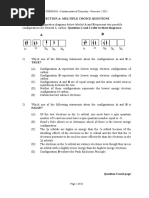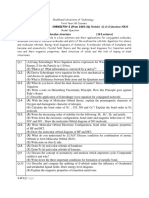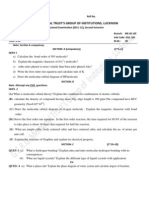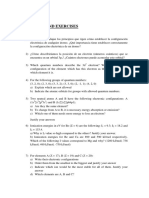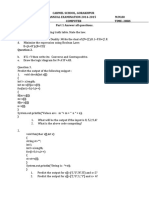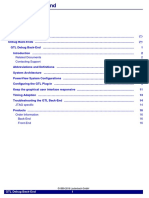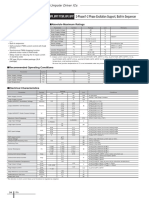Assignment 2
Uploaded by
Ayushman DwivediAssignment 2
Uploaded by
Ayushman DwivediBirla Institute of Technology & Science, Pilani, Rajasthan 333031
First Semester 2015-2016
Course Number: CHEM F111
Course Title: General Chemistry
Marks: 10
Tutorial Problem Set 2 (based on Lecture No.s: 10-13 in the course hand out)
Instructions to the student: The following problems should be solved as home assignment
within a week of display. Any one problem will be assigned as a closed book class test in the
following tutorial hour.
Q. 1 (a) What atomic terms are possible for the electron configuration np1nd1? Which
term is likely to lie lowest in energy? (b) Give the possible term symbols for (a) Sc:
[Ar]3d14s2, (b) Br: [Ar]3d104s24p5
[4+2+2+2]
Q. 2 (a) Suppose that an atom has 2 electrons in different orbitals. What are the possible
values of the total spin quantum number S? What is the multiplicity in each case?
[2+2]
(b) What values of J may occur in the terms (i) 2P, (ii) 3P? How many states
(distinguished by the quantum number MJ) belong to each level?
[3+3]
+
2
Q. 3 (a) Arrange the species O2 , O2, O2 , O2 in order of increasing bond length. (b)
From the ground-state electron configurations of B2 and C2, predict which molecule
should have the greater bond dissociation energy.
[4+4]
2
1/2
1/2
Q. 4 (a) Show that the sp hybrid orbital (s + 2 p)/3 is normalized to 1 if the s and p
orbitals are normalized to 1. (b) Normalize the molecular orbital A +B in terms of the
parameter and the overlap integral S.
[4+4]
Q. 5 (a) Write the term(s) corresponding to the ground state electronic configuration of
Cu2+ ion ([Ar]3d9) and identify the lowest energy level. (b) Which of the following
molecules N2, C2 and O2 would you expect to be stabilized by (i) the addition of an
electron to form A2-; (ii) the removal of an electron to form A2+?
[5+5]
Q. 6 (a) Obtain all possible terms and the levels arising from the excited electronic
configuration 1s12s1 of helium atom. State the degeneracy of each term and each level.
[2+2+2]
(b) Write the wavefunctions (ignoring normalization) corresponding to the MS=0-triplet
and singlet states arising from this configuration if the wavefunction corresponding to
MS=1-triplet is
triplet(1,2)(MS=1) = [1s(1) 2s(2) 2s(1)1s(2)](1)(2)
[2+2]
Q. 7 (a) Determine the hybridization of each of the following hybrid atomic orbitals
formed from combination of two pure atomic orbitals: s and pz.
[2+2+2]
(I) 1 = 2-1/2(s + pz) (II) 1 = 3-1/2(s 21/2pz) (III) 1 = 0.5(s + 31/2pz)
(b) Write the ground state electronic configuration of O2 molecule using LCAO-MO
orbitals. What will be the bond order of the molecule if one of the electrons in the highest
occupied MO (HOMO) is excited to one of the lowest occupied MO (LUMO) ?
[2+2]
Q. 8 (a) Does the bond order of a molecule in the given electronic state depend on the
spin-multiplicity of the state? Justify your answer using the excited electronic
configuration of H2 molecule: g1u1.
[2+2]
(b) Using LCAO-MO approximation, express the molecular orbitals g and u of H2
molecule as linear combination of atomic orbitals 1sa and 1sb centered on atoms a and b.
[2]
(c) Express the normalized ground state wavefunction of H2 in terms of the molecular
orbitals and explicitly written spin-part. Calculate the bond order.
[2+2]
Q. 9 (a) A valence bond of a diatomic molecule is expressed by the following normalized
wavefunction:
(1,2) = ccovalent covalent + cionic ionic
(I) Assuming that (1,2), covalent and ionic are normalized, state whether the bond is
dominantly covalent or ionic if ccovalent = 0.6. Calculate the % ionic character of the bond.
[3]
(II) If a and b are the atomic orbitals (centered on the atoms, A and B) involved in the
valence bond, express the covalent in terms of a and b ignoring the normalization
constant and the spin-part.
[1]
(b) Can a wavefunction of a two-electron system be antisymmetric with respect to both
spatial and spin parts simultaneously? What is the spin multiplicity of a two-electron
wavefunction corresponding to symmetric with spin-part? Explain using the spin
expressions.
[6]
Q. 10 (a) How many electronic states of an atom are represented by the term 4G.
[1]
(b) Determine all the possible levels corresponding to this term.
[4]
(c) State the degeneracy of all the levels.
[4]
(d) Assuming the given term to be ground term corresponding to electronic configuration
with a less than half-full subshell and the rest of the subshell either full or empty, identify
the ground level.
[1]
******END******
You might also like
- Hourglass Workout Program by Luisagiuliet 276% (21)Hourglass Workout Program by Luisagiuliet 251 pages
- The Hold Me Tight Workbook - Dr. Sue Johnson100% (16)The Hold Me Tight Workbook - Dr. Sue Johnson187 pages
- Read People Like A Book by Patrick King-Edited62% (66)Read People Like A Book by Patrick King-Edited12 pages
- Livingood, Blake - Livingood Daily Your 21-Day Guide To Experience Real Health77% (13)Livingood, Blake - Livingood Daily Your 21-Day Guide To Experience Real Health260 pages
- COSMIC CONSCIOUSNESS OF HUMANITY - PROBLEMS OF NEW COSMOGONY (V.P.Kaznacheev,. Л. V. Trofimov.)94% (212)COSMIC CONSCIOUSNESS OF HUMANITY - PROBLEMS OF NEW COSMOGONY (V.P.Kaznacheev,. Л. V. Trofimov.)212 pages
- Donald Trump & Jeffrey Epstein Rape Lawsuit and Affidavits83% (1016)Donald Trump & Jeffrey Epstein Rape Lawsuit and Affidavits13 pages
- The 36 Questions That Lead To Love - The New York Times94% (34)The 36 Questions That Lead To Love - The New York Times3 pages
- The 36 Questions That Lead To Love - The New York Times95% (21)The 36 Questions That Lead To Love - The New York Times3 pages
- Jeffrey Epstein39s Little Black Book Unredacted PDF75% (12)Jeffrey Epstein39s Little Black Book Unredacted PDF95 pages
- The 4 Hour Workweek, Expanded and Updated by Timothy Ferriss - Excerpt23% (954)The 4 Hour Workweek, Expanded and Updated by Timothy Ferriss - Excerpt38 pages
- SOLUTIONS To PROBLEMS - Callister Materials Science Solutions Manual - 2 - 1075% (4)SOLUTIONS To PROBLEMS - Callister Materials Science Solutions Manual - 2 - 109 pages
- Section A: Multiple Choice Questions: 1s 2s 2p 2p 2p 1s 2s 2p 2p 2pNo ratings yetSection A: Multiple Choice Questions: 1s 2s 2p 2p 2p 1s 2s 2p 2p 2p9 pages
- NANJA CH 110. Tutorial Sheet 6 (Atomic Structure) - FM 2024.No ratings yetNANJA CH 110. Tutorial Sheet 6 (Atomic Structure) - FM 2024.2 pages
- Module 1: Atomic and Molecular Structure (10 Lectures) : CHEMISTRY-I (From 2020-21) Module1 (12 of 12-Question) - MKMNo ratings yetModule 1: Atomic and Molecular Structure (10 Lectures) : CHEMISTRY-I (From 2020-21) Module1 (12 of 12-Question) - MKM3 pages
- (In Vacuum With Medium Dielectric Constant 1No ratings yet(In Vacuum With Medium Dielectric Constant 11 page
- Chemistry and Aliphatic Hydrocarbons: Questions1 Carry19 Marks and Questions 2, and 3 Carry18.5 Marks EachNo ratings yetChemistry and Aliphatic Hydrocarbons: Questions1 Carry19 Marks and Questions 2, and 3 Carry18.5 Marks Each2 pages
- Chem 373 - Lecture 27: Homonuclear Diatomic Molecules-IINo ratings yetChem 373 - Lecture 27: Homonuclear Diatomic Molecules-II22 pages
- Lecture 8. Electron Configuration and Chemical PeriodicityNo ratings yetLecture 8. Electron Configuration and Chemical Periodicity57 pages
- BBF 0013 Chapter 2 Electronic ConfigurationsNo ratings yetBBF 0013 Chapter 2 Electronic Configurations2 pages
- Autumn Break Assignment Chemistry Class 11No ratings yetAutumn Break Assignment Chemistry Class 113 pages
- Infrared Spectroscopy of Diatomics for Space ObservationFrom EverandInfrared Spectroscopy of Diatomics for Space ObservationNo ratings yet
- Computational Methods in Lanthanide and Actinide ChemistryFrom EverandComputational Methods in Lanthanide and Actinide ChemistryMichael DolgNo ratings yet
- Nanometer-scale Defect Detection Using Polarized LightFrom EverandNanometer-scale Defect Detection Using Polarized LightNo ratings yet
- Electron Beam-Specimen Interactions and Simulation Methods in MicroscopyFrom EverandElectron Beam-Specimen Interactions and Simulation Methods in MicroscopyNo ratings yet
- Example: Lateral Vibration of Beams: y (X, T 0) yNo ratings yetExample: Lateral Vibration of Beams: y (X, T 0) y3 pages
- Instruction Division Timetable First Semester 2018-2019 August 18, 2018No ratings yetInstruction Division Timetable First Semester 2018-2019 August 18, 201846 pages
- Vertical Coal Mill: Application Item Burning ProcessNo ratings yetVertical Coal Mill: Application Item Burning Process1 page
- Data Logger (Acceleration and Velocity) : 2. ObjectivesNo ratings yetData Logger (Acceleration and Velocity) : 2. Objectives4 pages
- Carmel School, Gorakhpur Annual Examination 2014-2015 M.M.80 Class Xi Computer Time: 2Hrs Part 1 Answer All QuestionsNo ratings yetCarmel School, Gorakhpur Annual Examination 2014-2015 M.M.80 Class Xi Computer Time: 2Hrs Part 1 Answer All Questions2 pages
- Robert Bosch Placement Paper 1 - Freshers ChociNo ratings yetRobert Bosch Placement Paper 1 - Freshers Choci11 pages
- A Flywheel Is A Rotating Mechanical Device That Is Used To Store Rotational EnergyNo ratings yetA Flywheel Is A Rotating Mechanical Device That Is Used To Store Rotational Energy11 pages
- NXZ Series Automatic Transfer Switching EquipmentNo ratings yetNXZ Series Automatic Transfer Switching Equipment31 pages
- OV9281 Preliminary Specification CSP5 - Version 1 22 - OmnivisionNo ratings yetOV9281 Preliminary Specification CSP5 - Version 1 22 - Omnivision133 pages
- Sla7070mr, MPR, MPRT/7071MR, MPR, MPRT/7072MR, MPR, MPRT/7073MR, MPR, MPRTNo ratings yetSla7070mr, MPR, MPRT/7071MR, MPR, MPRT/7072MR, MPR, MPRT/7073MR, MPR, MPRT2 pages


































